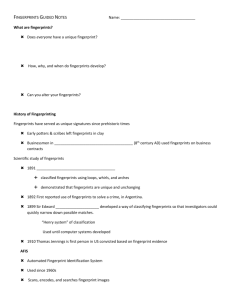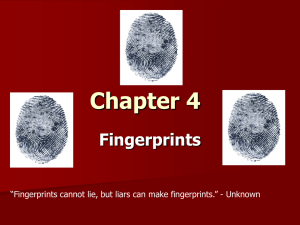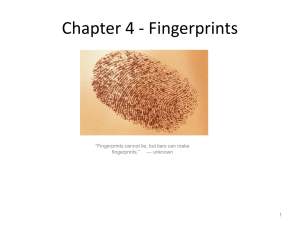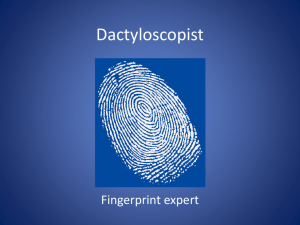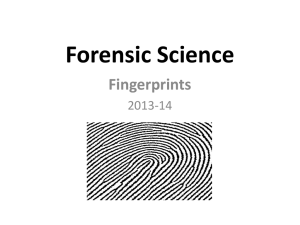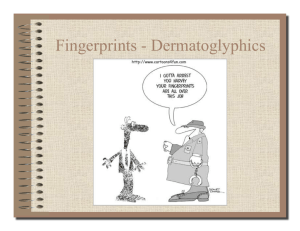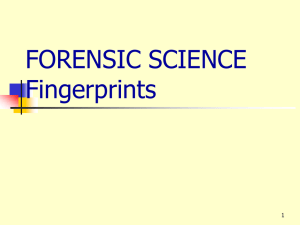Dactyloscopy project - ecrimescenechemistrymiller
advertisement
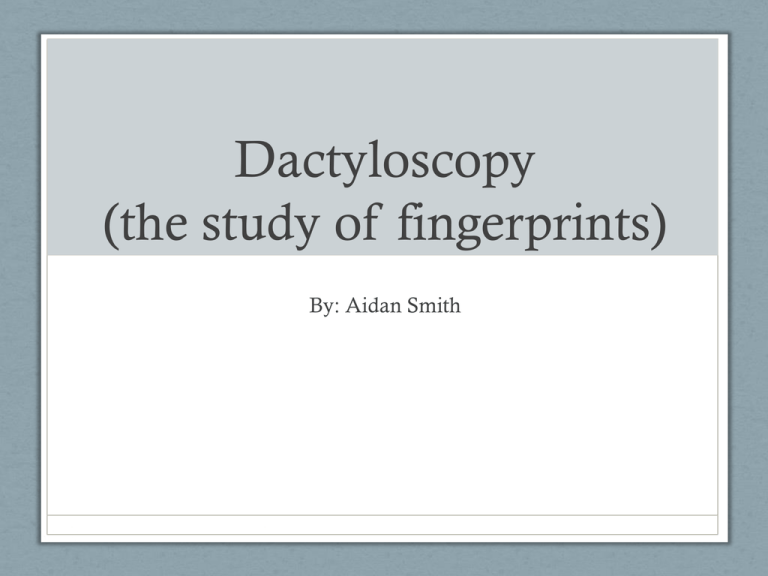
Dactyloscopy (the study of fingerprints) By: Aidan Smith Types of Fingerprints • There are three different types of Fingerprints • Loops • Arches • Whorls Loops • Loops are the most common making up about 60 to about 70 percent of all fingerprints • They come in from the sides of the finger and loop around in the middle of the finger and go out the same side it came in • Usually have one delta Picture of a Looped Fingerprint Whorls • Whorls make up about 25 to 35 percent of all fingerprints • Usually have their own circle(s) • Two deltas classify a Whorl • Many types of Whorls • Plain, accidental, pocket Whorls Picture of Whorl Arches • Make up about 5 percent of all Fingerprints • There is no delta • Ridges stretch across the finger • Tented Arches look like it could be a delta Pictures of an Arch and Tented Arch Regular Arch Tented Arch Types of Prints • Three different ways to have a fingerprint • Latent • Patent • Plastic Latent Prints • Latent prints are probably the most common type of print to find • These prints are invisible to the human eye without a black light or “dusting” • Fingerprints leave behind residue (sweat, oils) which is only found with these tools Patent Prints • Visible to the human eye without the needs of any special tools • Usually photographed Plastic Prints • Easily findable • Left in blood, melted wax, etc. • Easily visible to human eye • Photographed Techniques • Photographing • Take pictures of the fingerprints and scan them into a computer as well as chemically developing fingerprints, put them on a contrasting background • “Dusting” • Involves brushing areas at a crime scene with chemicals so that fingerprints will show up • Picked up with clear tape and put on background so they will contrast and are able to work with print Education • Usually need a college degree or equivelent (Biology and Chemistry are good degrees) • Need a couple years experience in the field. Many learn as they work with older more experienced experts Carmine Artone Retired Supervisor of US Secret Service, Identification Branch • Started her career right out of high school, never went to college. Never earned her degree. • After working for the FBI she went to the Miami Dade Police where she was trained in Latent fingerprint identification • Normal days consisted of examining crime scene prints and comparing then to known criminals…very tedious since the prints were never complete or clear • Most Dactyloscopists don’t have another job Carmine Atone…continued • She testified in many court cases about the evidence she found and many times her evidence (fingerprints) were very important • One case she remembers she was called to testify and the prints she had found in blood on the victim’s clothes were consistent with the killer’s prints • Thus she helped convict the man for murder Court Case 1911 • Chicago, Illinois. December 21, 1911 • Thomas Jennings tried for murder of Clarence Hiller who was shot • Fingerprints were found in fresh paint left from a job earlier that day. The fingerprints matched Jennings’s prints. Ballistics also matched their test bullet to that of Jennings bullet at the crime scene. • To be sure that the fingerprints were real and that it wasn’t tampered evidence several experts were witnesses to the evidence • With the help of this evidence Jennings was convicted and hanged on February 16, 1912 Bibliography • http://74.125.45.104/search?q=cache:XhZhwUKZ1jwJ:www.lakesidesch ool.org/upperschool/departments/science/forensics/documents/CaseStu dyFingerprints.doc+thomas+jennings+case&hl=en&ct=clnk&cd=2&gl=us • http://www.brazoria-county.com/sheriff/id/fingerprints/tarch.jpg • http://www.britannica.com/EBchecked/topic/149492/dactyloscopy • http://en.wikipedia.org/wiki/Fingerprint • http://www.forensic-science-info.com/images/whorl-fingerprint.jpg • http://www.fprints.nwlean.net/j.htm • http://www.mondovista.com/fingerprint2.jpg Bibliography Con’t • http://onin.com/fp/fpxperts.html • http://www.policensw.com/info/fingerprints/finger07.ht ml • http://www.policensw.com/info/fingerprints/indexfinge r.html • http://www.policensw.com/info/fingerprints/images/pa rcha.jpg • http://ridgesandfurrows.homestead.com/science.html




